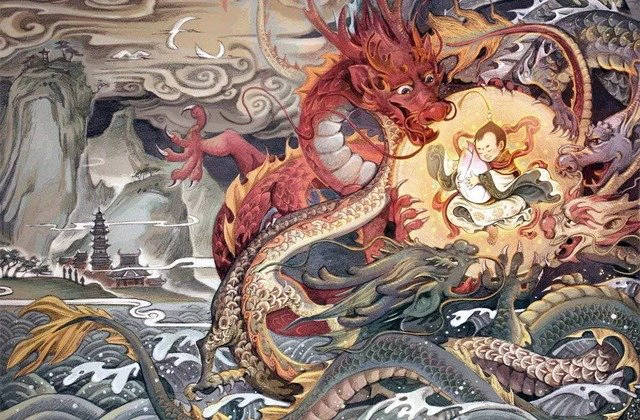China's top ten folk arts and crafts list
Folk crafts are the artistic embodiment of the folk customs of the masses. According to the material classification, there are various types of folk made of different materials such as paper, cloth, bamboo, wood, stone, leather, metal, surface, clay, ceramics, straw and willow, brown rattan, lacquer, etc. Handicrafts. So what are the traditional Chinese folk arts? This article counts China’s top ten folk crafts, including paper-cutting, New Year pictures, embroidery, ceramics, lanterns, clay sculptures, wood carvings, kites, bamboo weaving, shadow puppets, etc.
1: Chinese paper cutting
Paper-cutting, also known as paper-cutting, is a folk art with a long history and a broad popular base. It is the crystallization and precious heritage of the working people. It occupies an important position in folk activities and is a national intangible cultural heritage. Its representative schools: Yuxian paper-cutting, Shanxi paper-cutting, Shaanxi paper-cutting, Shandong paper-cutting, Yangzhou paper-cutting, Foshan paper-cutting, Fujian paper-cutting.

2. Years Painting
New Year paintings are commonly known as door gods and happy paintings. They are a unique Chinese folk art form, an important part of the Spring Festival folk culture, the most common folk art of the Han nationality, and a unique painting genre of the Han nationality. It is represented by Sichuan Mianzhu New Year Pictures, Tianjin Yangliu Youth Pictures, Suzhou Taohuawu New Year Pictures, Zhuxian Town Woodblock New Year Pictures, Foshan Woodblock New Year Pictures, and Weifang Yangjiabu New Year Pictures.

3. Embroidery
Embroidery, also known as silk embroidery, has a long history of national traditional crafts, magnificent Chinese folk crafts, the crystallization of wisdom of ancient Chinese women, and a comprehensive art integrating traditional hand-cut paper-cutting/embroidery/making craftsmanship. Four famous embroidery: Su embroidery, Guangdong embroidery, Shu embroidery, Hunan embroidery; Four famous brocades: Suzhou Song brocade, Chengdu Shu brocade, Nanjing Yun brocade, Guangxi Zhuang brocade; embroidery, cross stitch (cross stitch), applique and other crafts, cloth tiger, embroidered purse.

4. Ceramics
Ceramics began in the Neolithic Age, a treasure of the splendid culture and art of the Chinese nation, an important part of folk crafts, and masterpieces of ancient Chinese chemical crafts and arts and crafts. Representative factions: Three masterpieces of traditional Chinese crafts: Beijing cloisonne, Fujian born lacquerware, Porcelain in Jingdezhen, Jiangxi; as well as Longquan celadon, Yangzhou lacquerware, Luoyang Tang Sancai, Beijing carved lacquer, Pingyao push light lacquer, etc.

5. Lanterns
Lanterns, also known as lanterns, are traditional Chinese folk crafts of the Han nationality, an important entertainment culture of the Han nationality for thousands of years, and a gem of the Han nationality's folk culture. Lantern Festival is the custom of Lantern Festival, which has both life function and artistic characteristics. Famous factions: Chaozhou Lantern, Zhixi Lantern, Xiushan Lantern, Quanzhou Lantern, Beijing Palace Lantern.

6. Clay sculpture
Tianjin City, Jiangsu Province, Henan Province, Shaanxi Province. Clay sculptures are commonly known as colored sculptures and clay play. They are ancient Chinese folk traditional arts, folk handicrafts with a long history, traditional crafts close to life and artistic charm, and national intangible cultural heritage. Its representatives are Tianjin Clay Figure Zhang (Chinese Dream Baby), Huishan Clay Figure, Wuxi Colored Sculpture, Fengxiang Clay Sculpture, Gaomi Clay Sculpture, Dunhuang Clay Sculpture.

7. Wood Carving
Shandong Province, Hubei Province, Macao Special Administrative Region. Wood carving originated in the Neolithic Period. It is an ornamental handicraft carved from wood and tree roots. It is a national intangible cultural heritage and is divided into three categories: round carving, root carving and relief carving. Its representative factions: Dongyang wood carving, Quanzhou wood carving, Yueqing boxwood wood carving, Chaozhou gold lacquered wood carving, Fujian longan wood carving.

8. Kites
Kite, nicknamed paper kite, was invented by the working people of the Han nationality in the Spring and Autumn Period of the Eastern Zhou Dynasty. It is a folk art with a long history and superb craftsmanship. The four arts of kite making: tie, paste, paint, and fly. Kite flying is the traditional custom of Qingming Festival and the kite capital of the world. : Weifang, other factions: Yangjiang Kite, Kaifeng Kite, etc.

9. Bamboo Weaving
Bamboo weaving is a characteristic handicraft of the Han nationality, the crystallization of the hard work and wisdom of the Chinese working people. It has a long history and exquisite craftsmanship, and is a national intangible cultural heritage. Its representative factions: Dongyang bamboo weaving, West Fujian bamboo weaving, Sansui bamboo weaving, Zigong Gong fan, Ningbo straw mat, Jinling folding fan, Suzhou sandalwood fan, Tianzhu chopsticks, etc.

10. Shadow Play
Shadow puppet play, also known as "shadow play" or "light shadow play", is a kind of folk play in which silhouettes of figures made of animal skins or cardboard are used to perform stories. It is a national intangible cultural heritage. Its representative factions are: Sichuan shadow play, Hubei shadow play, Hunan shadow play, Beijing shadow play, Tangshan shadow play, Shandong shadow play, Shanxi shadow play, Qinghai shadow play, Ningxia shadow play, Shaanxi shadow play, and northern Sichuan shadow play, Longdong shadow play and so on.


In history, not all emperors were dedicated and dedicated, and there were also those unreliable emperors who led to the ruin of their country and their families.

At the beginning of 2020, the new crown epidemic began to spread around the world, and the aviation industry was hit hard. Data source Q3 2021 CAPSE.

Wedding is a "life-long event" in a person's life, and its status in the transition of life is very important, so ancient and modern Chinese and foreign people......

The Chinese people have developed creative thinking since ancient times and have a glorious tradition of invention.

Myths are a type of folklore. Its production shows the ancient people's struggle against natural forces and their pursuit of ideals.